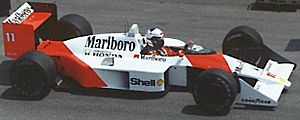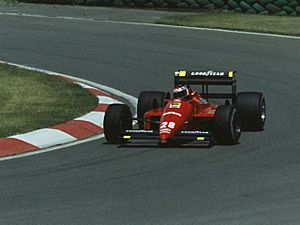1988 Formula One World Championship facts for kids
| 1988 FIA Formula One World Championship |
|||
| Drivers' Champion: Ayrton Senna Constructors' Champion: McLaren-Honda |
|||
| Previous: | 1987 | Next: | 1989 |

The 1988 Formula One World Championship was the 42nd season of Formula One motor racing. It included 16 exciting races from April to November. The main goal was to find the best driver and the best car-making team.
Ayrton Senna became the World Champion driver. His team, McLaren-Honda, won the championship for car makers. Senna and his teammate, Alain Prost, were incredibly dominant. They won 15 out of the 16 races! The only race they didn't win was the 1988 Italian Grand Prix. In that race, Ferrari driver Gerhard Berger took a special victory. This happened just four weeks after the death of Ferrari's founder, Enzo Ferrari. McLaren's score of 199 points was a record for a long time. It was more than three times what any other team scored!
Contents
Teams and Drivers
Many teams and drivers competed in the 1988 Formula One season. All cars used tires from Goodyear.
Some of the top teams and drivers included:
- Lotus-Honda with drivers Nelson Piquet and Satoru Nakajima.
- Williams-Judd with Nigel Mansell and Riccardo Patrese.
- McLaren-Honda with the superstar duo Alain Prost and Ayrton Senna.
- Ferrari with Michele Alboreto and Gerhard Berger.
- Benetton-Ford with Alessandro Nannini and Thierry Boutsen.
Many teams chose to use new "naturally aspirated" engines. These engines don't use a turbocharger. This was because new rules meant turbos would be banned soon. Only a few teams, like McLaren and Ferrari, still used powerful turbo engines. McLaren and Lotus used Honda engines, which were very strong.
Race Calendar
The 1988 season had 16 races held around the world. Here are the races and where they took place:
Calendar Changes
Some races were changed for the 1988 season:
- The Austrian Grand Prix was removed because of safety worries at the track.
- The Belgian Grand Prix moved from May to August.
- The Mexican Grand Prix moved from October to May.
- The Canadian Grand Prix returned after being off the calendar for a year.
Season Highlights
The 1988 season was mostly about the amazing performance of the McLaren team. Their car, the McLaren MP4/4, was incredibly fast. It was powered by a strong Honda V6 turbo engine.



Pre-Season Buzz
Before the season started, everyone wondered if the Honda engines would make McLaren unbeatable. People also watched to see if Ferrari could continue their winning streak from late 1987. Many teams decided to use new "naturally aspirated" engines. These engines were less powerful than turbos but would become standard in 1989. This gave them a head start on the new rules.
The rules for turbo engines were made much stricter in 1988. They had less power and could carry less fuel. This was done to make the races fairer and bring the non-turbo cars closer.
McLaren's Dominance
The McLaren team, with drivers Ayrton Senna and Alain Prost, was in a league of its own. Their car was perfectly designed for the new rules. They won the first eight races in a row! Senna and Prost each won four of these races.
- Round 1 – Brazil: Prost won the first race. Senna was disqualified for changing to a spare car after the race had officially started.
- Round 2 – San Marino: McLaren showed how strong they were. Senna and Prost finished first and second, lapping every other car on the track!
- Round 3 – Monaco: Senna was leading easily but crashed near the end. This gave Prost the win. It was a rare mistake from Senna.
- Round 4 – Mexico: Another 1-2 finish for McLaren. Turbo cars did very well here because of the high altitude.
- Round 5 – Canada: Senna won, with Prost second. This was the first time the two McLaren drivers really battled on the track for the lead.
- Round 6 – Detroit: Senna won again, making it three wins in a row for him in Detroit. McLaren had now won all six races of the season.
- Round 7 – France: Prost won his home Grand Prix. He and Senna had another close fight on the track.
- Round 8 – Britain: Gerhard Berger took pole position for Ferrari, breaking McLaren's streak. But Senna still won the race. Nigel Mansell surprised everyone by finishing second in his non-turbo Williams car.
By this point, McLaren had won all eight races. Prost was leading the championship, but Senna was close behind.
The Second Half of the Season
- Round 9 – Germany: Senna won again, with Prost second. The long straight at Hockenheim showed how powerful the turbo cars still were.
- Round 10 – Hungary: Senna won his sixth race of the season. Prost fought hard to finish second.
- Round 11 – Belgium: Senna won again. McLaren secured the Constructors' Championship very early in the season. This was the first race after the death of Enzo Ferrari, the founder of the Ferrari team.
- Round 12 – Italy: This was the only race McLaren didn't win. Prost's engine broke down. Then, Senna crashed while trying to lap another car. This allowed Gerhard Berger and Michele Alboreto to finish first and second for Ferrari. It was a very emotional win for Ferrari after Enzo Ferrari's passing.
- Round 13 – Portugal: Prost won, taking back the championship lead. Senna finished sixth after struggling with his car.
- Round 14 – Spain: Prost won again, trying to keep his championship hopes alive. Senna finished fourth.
- Round 15 – Japan: This was the race where the championship was decided. Prost started well, but Senna stalled his car. However, Senna made an incredible comeback, passing many cars. He eventually passed Prost to win the race and become the 1988 World Champion!
- Round 16 – Australia: Prost won the final race of the season. This was the last Formula One race for turbo engines until 2014.
Season Summary
Ayrton Senna won the Drivers' Championship with eight wins. Alain Prost finished second, even though he had seven wins and more total points. The rules only counted the best 11 results. Senna's eight wins gave him more points under this system. Senna also set a new record for pole positions, with 13 poles in one season.
The McLaren-Honda team completely dominated the 1988 season. They won 15 out of 16 races. This was a record-breaking performance. The new rules for turbo cars did help the non-turbo cars get closer. Non-turbo cars managed to get on the podium several times, but they could never beat the powerful McLarens.
Results and Standings
Scoring System
Points were given to the top six drivers in each race:
| Position | 1st | 2nd | 3rd | 4th | 5th | 6th |
|---|---|---|---|---|---|---|
| Points | 9 | 6 | 4 | 3 | 2 | 1 |
For the Drivers' Championship, only the best 11 race results counted towards the final score.
World Drivers' Championship Final Standings (Top 6)
- 1. Ayrton Senna (McLaren-Honda): 90 points
- 2. Alain Prost (McLaren-Honda): 87 points
- 3. Gerhard Berger (Ferrari): 41 points
- 4. Thierry Boutsen (Benetton-Ford): 27 points
- 5. Michele Alboreto (Ferrari): 24 points
- 6. Nelson Piquet (Lotus-Honda): 22 points
World Constructors' Championship Final Standings (Top 3)
Images for kids
See also
 In Spanish: Temporada 1988 de Fórmula 1 para niños
In Spanish: Temporada 1988 de Fórmula 1 para niños



